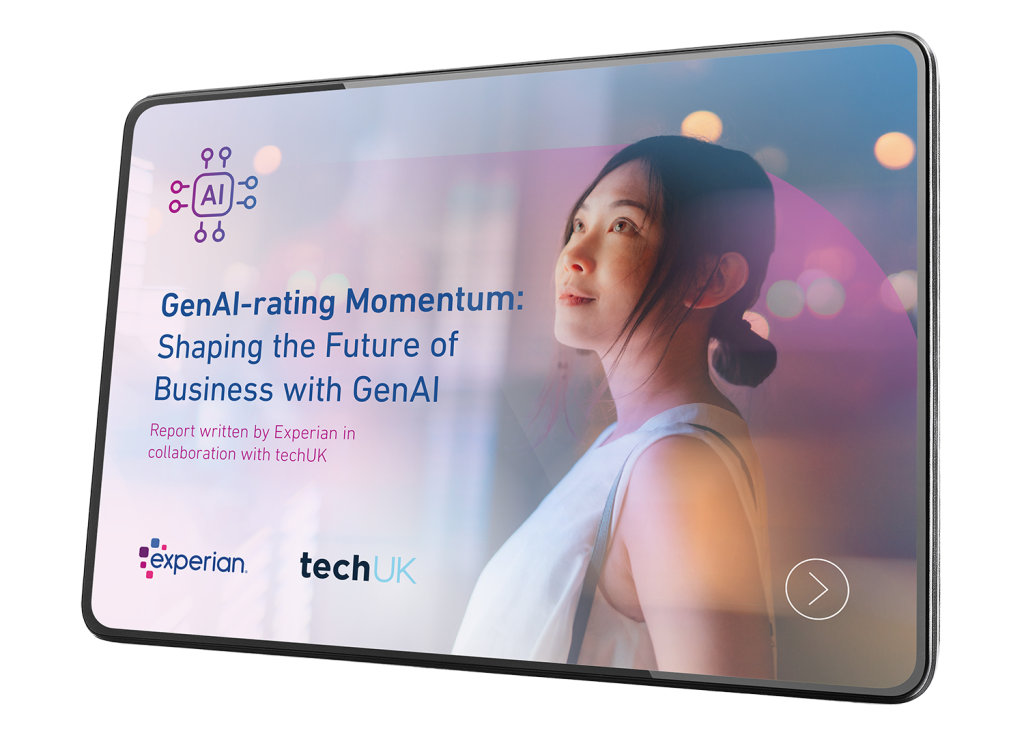Shaping the future of business with GenAI
Generative AI is the latest industry “must-have”, but how are businesses using the technology to enhance performance?
Download our report nowGenAI presents an incredible opportunity to supercharge the way we work and live.
And it is here to stay.
This technology is not a genie that can be put back in the bottle. Instead, we must embrace it – responsibly. Our latest report in partnership with techUK shares unique insight into how UK CEOs and employees are using GenAI, and how businesses can look to integrate the technology into their daily practices.
In this report, we cover:
Unique insight into how GenAI is being used across the UK business network
What challenges are there in using GenAI and how do CEO and employee viewpoints differ?
Guiding principles for integrating GenAI into your business including the importance of data quality
Future trends for GenAI
A sneak peek into:
GenAI-rating Momentum: Shaping the future of business with GenAI
The guiding principles
The findings show significant differences in understanding the impact and prominence GenAI will have in businesses, emphasising the critical need to take all employees on the journey. In addition, the research highlights several key challenges for businesses using GenAI, including data quality, measurement and evaluation, regulation, security, and skills.
With that in mind, we have created five guiding principles to help businesses take the next step forward with GenAI. Central to these principles is creating a secure environment including setting clear policies and educating employees on appropriate tools and practices.

1. Data quality must come first
GenAI’s transformative potential comes from its ability to analyse and unify large amounts of information rapidly, allowing organisations to unlock meaningful insights. However, the effectiveness of GenAI is fundamentally reliant on the quality of data it is trained on. For GenAI models to function effectively, they require relevant, complete, accurate, and clean data. Otherwise the risk of bias or even “hallucinations” – when GenAI produces responses that are inaccurate or false – increases. This can pose serious reputational and compliance risks, particularly in business and critical applications where accurate information is essential.
Did you enjoy the read?
Download the full 'GenAI-rating Momentum' report now
Read our paper to find out the latest in GenAI use, as well as the challenges and opportunities for the future. We discuss how to integrate GenAI into your business, and what CEOs are saying they need for success.

Jonathan: Well, hello, I’m Jonathan Westley. I’m the Chief Data Officer of Experian UK. And I’m joined here with Jacqueline de Rojas, who is President Emeritus of techUK. We’re here to talk about Generative AI. The first thing that we probably want to talk about is what’s important when you look at Generative AI. We automatically think of algorithms and models, but they really only function with good quality data.
Jacqueline: Absolutely right. The great thing about GenAI, though, is that it does make sense of unorganised data. You do need to have good quality data, but it’s also alright if it’s a little bit chaotic because GenAI can make sense of it. And you also need to create a framework where you’re creating a world that is responsible. This is a technology that learns from itself and scales at speed. So if you have one tiny moment of bias, it will be exponentially replicated. And what that means is we need all of our voices at the table.
Jonathan: One of the things that employers and companies need to think about is the transition of their organisation, and they probably need to think about the skills, the training and the development to take their employees with them on this journey.
Jacqueline: Well, this is the man-machine collaboration, so it’s not one replacing the other.
Jonathan: That’s right, and you almost have to create the environment that allows for innovation and creativity. The problem is, how do I create agility within an organisation to be creative and innovative and put some guardrails on? And the guardrails don’t compress that agility? Businesses have got to recognise that they’ve got to have the flexibility within the workforce, within their processes and within their environment to allow the employee base to create.
Jacqueline: Absolutely, we do absolutely. Like with all technology, we need to make sure there are guardrails in place.
Jonathan: Agreed. The new generation, as they come into the employment, are going to have to have these skills or develop these skills. But they’re also of a mindset that they are more digitally minded and so adapt to it much more quickly.
Jacqueline: They do. But there’s also this interesting thing about sector knowledge. So, for example, if you are already legally trained as a lawyer and you get a little bit of GenAI and future skills capability, the legal skills sector knowledge and the AI together – that creates a one plus one equals 11, I think. So the sector knowledge can’t be ignored. I think it’s not just the tech knowledge. It’s the combination of the two that’s fascinating and can move mountains.








